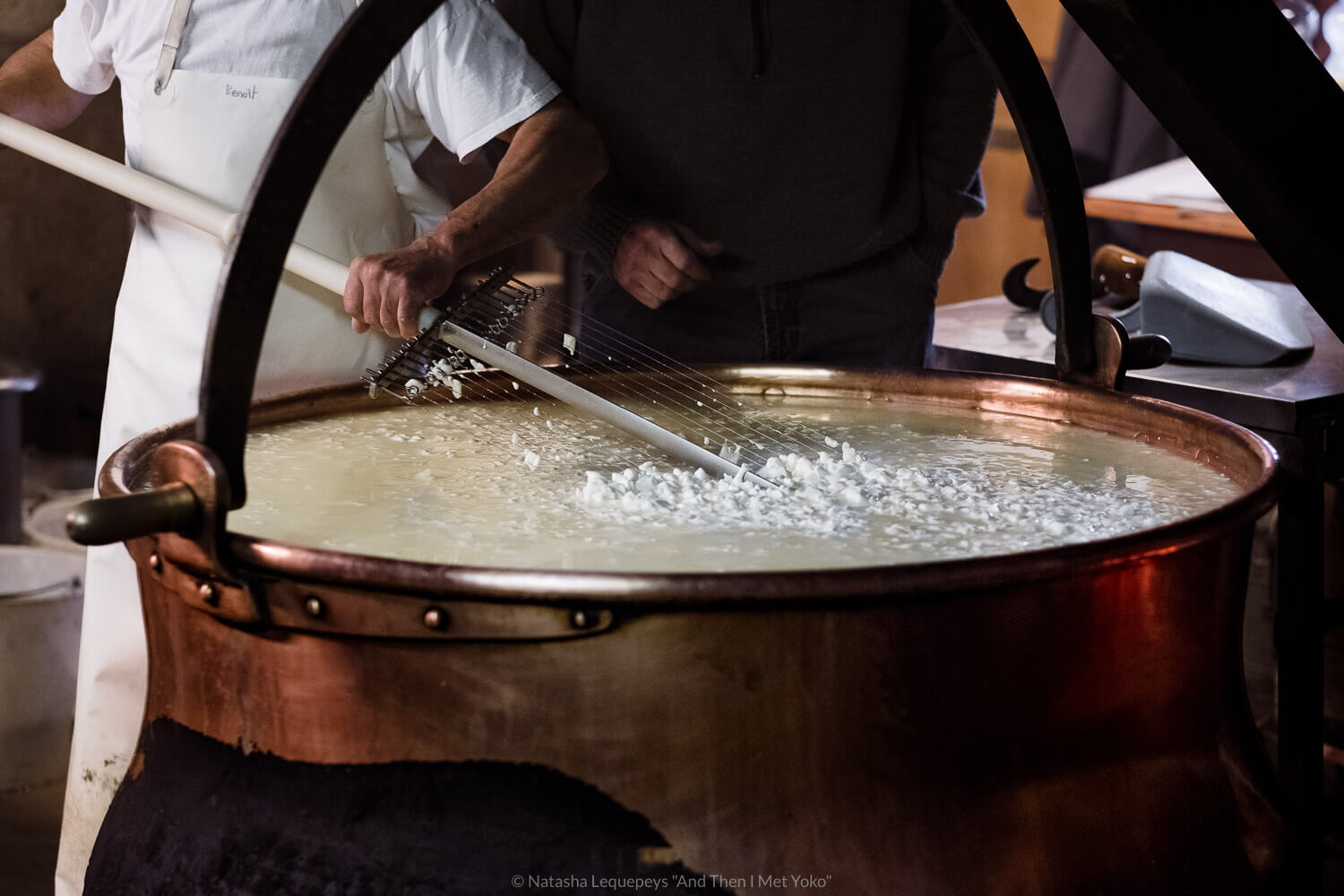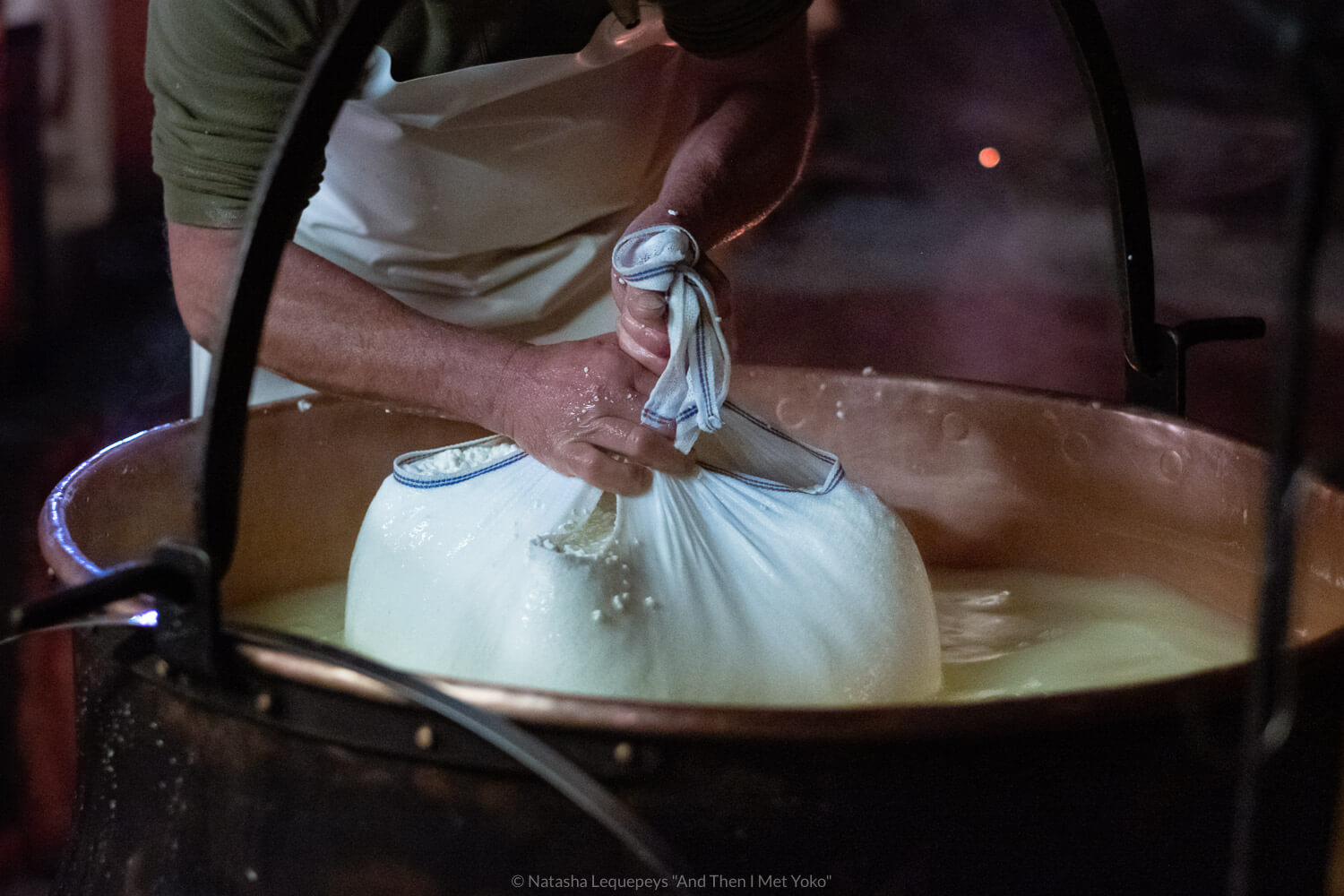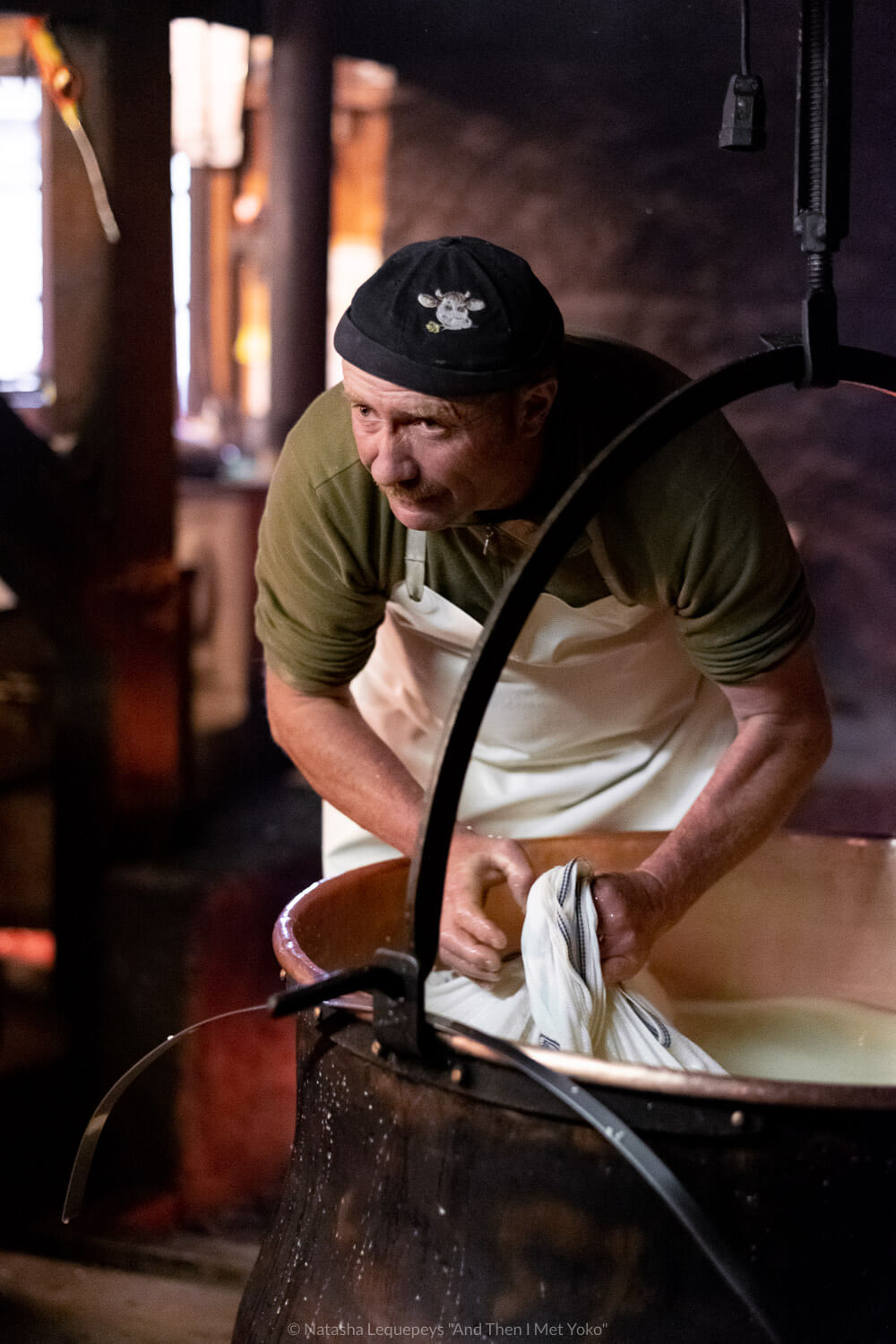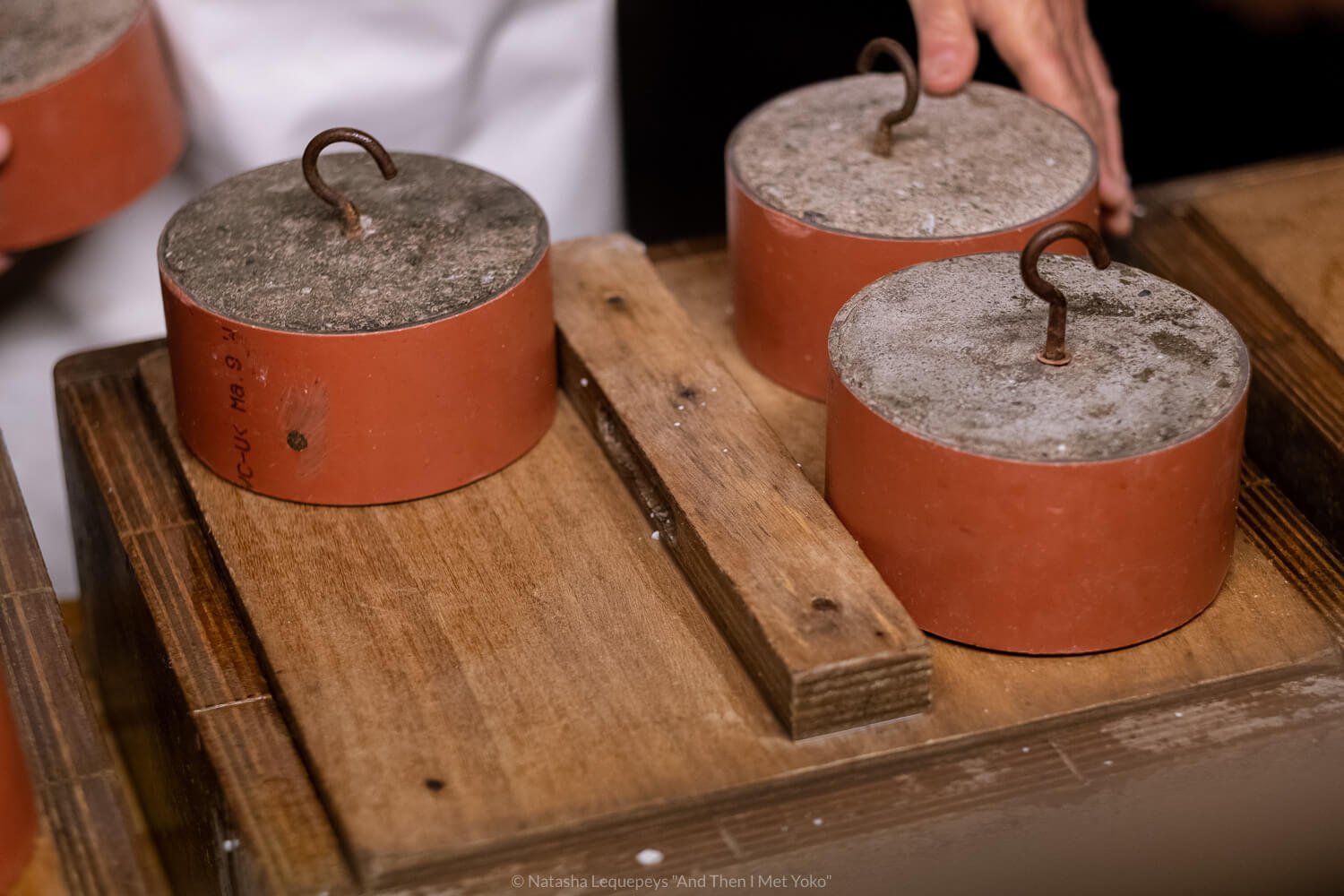An Inside Look into Alpine Cheese Making | Moléson-Sur-Gruyères, Switzerland
No visit to Switzerland, let alone Gruyère, would be complete without seeing how cheese is made. And while I really enjoyed the large-scale factory at la Maison du Gruyère, I was even more impressed with the intimate alpine cheese chalet in Moléson-sur-Gruyères.
Just a short bus ride from the Gruyères train station you can ascend into the Swiss mountains and watch expert cheesemakers demonstrate their traditional techniques; a process that dates back to 1686!
Curious about how cheese is made the alpine way? I share learnings from my experience plus tips on how to visit on your own.
GO IF YOU LIKE:
Chalets | smoky smells | Traditions | Cheese | Hiking | Scenic Vistas
The Alpine Cheese-Making Process
Step 1 - Making Curds out of Milk
The Fromagerie process begins well before the 10am viewing time. Early in the morning, around 7.30am, the cheesemaker starts by heating milk in a large cauldron over a wooden fire. The goal is to get the milk to heat to 32 degrees celsius.
Cultures and yeast are added and the milk. From there they remove the cauldron from the fire and pressurize the liquid. About 30-45 minutes later the milk slowly turns to a yogurt consistency and starts to develop curds.
The room is dark and smoky with the sounds of the crackling fire, it makes for an intimate demonstration.
Pro Tip
Arrive for 10am. If you come later you will miss the action. 10am is when the process of checking the curds and transferring them to the moulds takes place and the entire process lasts only about 45 minutes. Reserve in advance to avoid disappointment.
Step 2 - Getting The curd Juuuuuuust right
Once the curds start to form, the cheesemakers stir with a cutting instrument, breaking up the solids. They inspect the curds for the right consistency and size. They’re looking for them to be the size of a hazelnut or a piece of corn.
They will take the curds in their hands, roll them around and break them to see if the texture has the correct firmness.
This stirring continues until the curds are just right. The heat will then be adjusted based on the type of cheese being produced. 34-37 degrees is required for the “Petit Moléson” or “Vacherin” style cheeses while Gruyère requires the heat to increase to 57 degrees celsius.
Step 3 - Transferring the Curds
Now the fun gets started! The cheesemaker needs to transfer the curds into the cheese moulds. In order to do this they use a large cheese cloth.
First they wrap the cloth around a metal rod, this allows them to form a net with the cloth. This is normally a two-person job but I got to witness a masterful cheesemaker who was able to make the transfer alone. He bit down and held the remaining two ends in his mouth and then scooped.
I was so impressed at the quantity he was able to secure in his cloth!
Step 4 - Filling the Cheese Moulds
Once the cheese is transferred to the moulds the cheesemaker presses down and removes excess liquids. The cheeses are marked with identifiers, telling the cheesemaker the type and manufacturing date of the batch.
The moulds used in this chalet are the traditional wooden ones which some cheesemakers believe add to the flavour of the cheese. It reminds me of how wine flavours are impacted by the type of barrel they’re aged in.
Weights are added on top of the moulds so that the cheese can develop into one solid piece. The moulds are then turned several times until the next day.
Step 5 - The Salt Baths and Aging Process
The cheesemaking process continues by submerging the cheese in a salt brine bath for 8-24 hours (depending on the variety). Finally they’re put in the cheese cellar where the cheesemaker continuously attends to them by brushing the cheese to remove mould and ensure it develops a nice rind.
The aging process varies based on variety. For example:
Petit Moléson: 7-8 weeks
Vacherin: 9 weeks to 6 months
Gruyère: 5-6 months to a year
I’ll leave you with my final thoughts
I had low expectations for this activity. In my research, prior to the visit, I had read mixed reviews. I think this stemmed from English speakers who may have felt like there was a lack of explanation during the demonstration or people who missed the 10am time slot and were disappointed.
Firstly, there is a video that explains the process and while it’s in French there were English (and I think German) subtitles. In addition, when you reserve just ask for an English translation and I’m sure someone will help answer any questions.
I didn’t need the cheesemakers to be talking during the demonstration because I was there to watch them work and I didn’t want to distract them from that. I also visited la Maison du Gruyère, which you can read about in this travel guide to Gruyère. This factory was also an interesting visit, however I preferred the intimacy of the alpine experience. If you can visit both then I highly recommend doing this because you get a sense of both the traditional and modern cheesemaking techniques.
Before or after the demonstration you can spend some time in the cozy chalet. There you can enjoy cheese, fondue and coffee which was much needed before heading back out into the rain. I had a lovely experience with Sophie, the chalet manager who answered all my questions and was very welcoming.
Pro Tip: Planning for two cheese demonstrations
If you’re in Gruyères for only one day and want to see the cheesemaking process at both the alpine chalet and la Maison du Gruyères, follow this timeline (these bus times were from May 2019, check online before your visit for most current schedule):
Bus at 9.09 am from Gruyères train station to Moléson-sur-Gruyères
10.00am alpine cheese demonstration
Bus at 10.37 am back to Gruyères train station
10.45 am visit La Maison du Gruyère - they should be in the final stages of production at this time.
Note: If you are late or wanted to spend more time in Moléson (there are summit views, see below) there is an afternoon cheesemaking demonstration at La Maison du Gruyères, between 12.30pm-2.30pm
Getting To Moléson-Sur-Gruyères
By Bus
Moléson-sur-Gruyères is a town located just outside of Gruyères itself. From the Gruyères train station you can take the local bus, NFB 263, which runs back and fourth between the two towns every hour.
Hiking
The town is on a hill so the inclination is steep but hiking there is also an option. If you’re interested in this, you may want to consider coming back down instead of going up. I had my heart set on doing this but it was pouring rain when I visited so hiking was out of the question.
There are so many great hikes in the region but unfortunately I didn’t have time to try them. If you’re spending a few days in the area grab a hiking map at the tourism center in Moléson-sur-Gruyères or Gruyères. The maps should give more information about trail lengths, duration and terrain.
Hours of Operation
Open all days of the week in the summer season
May-September from 9am-6pm (check online for official opening dates).
Cheese-making happens at 10am and only lasts 45 minutes so I highly recommend being there for this time or you miss seeing the process.
Reservations are recommended. My demonstration was silent, the cheese makers didn't explain anything as they worked. This was fine for me because they had a video playing that did all the exaplaining.
The video was in French with English subtitles. When making your reservation just mention if you'd like an English translation.
Cost of Admission
In 2019 the cost of admission was:
CHF 5 for adults
CHF 2 for kids under 14
CHF 4 for seniors or large groups (over 10 people, price per person)
Le Moléson Mountain
If you’re visiting Moléson-sur-Gruyères and it’s a nice day then consider visiting le Moléson summit for some panoramic views. On a good day you'll be able to see the different Alps regions (Fribourg and Valais) and potentially Mont Blanc. During the summer months, you can take the cablecar and funicular to the top.
I can’t give you recommendations or photos because it was pouring rain when I visited and the visibility was non-existent, but from what I saw online it looks like quite the beautiful view.
Cheesemaking Photography TIPS
The chalet is a tricky environment to shoot and I wouldn’t have been able to capture much without a lens that could open up and let in lots of light. Luckily I had the Fujinon XF 56mm F/1.2 and I shot almost everything at 1.4 and 1.2.
The challenge was my focus point, because at that aperture I missed focus on quite a few of my shots. So think through the story you want the shot to tell and focus on the right area because everything else will be soft.
The entire demonstration is also done behind a barrier, half of which was glass, so you’ll want to get setup in a good position.
The cheese maker went back and fourth transferring the curds about 4 times. So that’s about how many tries I had to get my shots.
It’s quite smoky in the room but I liked how that added to the atmosphere in the photos. I did use a bit of dehaze in post-production to sharpen some areas.
My visits in Gruyère were provided complimentary from Tourism Gruyère. All thoughts and opinions are my own.

































A visual travel guide and itinerary with 7 fun activities in Gruyeres, Switzerland. Includes cheese-making demonstrations, exploring the charming town and eating lots of fondue!